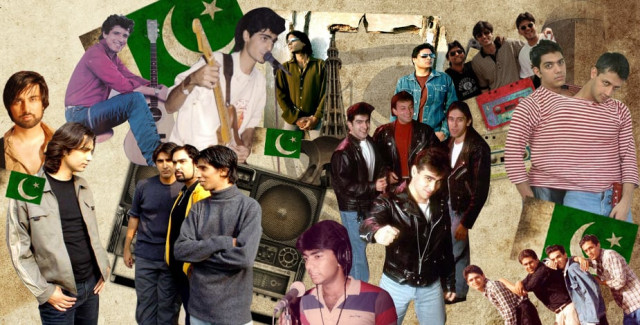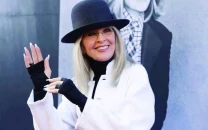Lost tales of Pakistan's 10 game-changing songs – Part 2
In the second part of this series, we look at the remaining five songs that revolutionised music in Pakistan

CREATIVE: AAMIR KHAN

Let’s dial back a bit, and pick up where we left of from in the second part of this series. The beginning of the 90s saw the music industry move out of the MCC (Music Channel Charts) days and shows like Top of the Pops and Video Junction (hosted by Faisal Qureshi and Ahsan Ibrahim) became a one-stop-shop for the latest on Pakistani music.
Junoon had started to shape up as the sensation it came to be and Vital Signs was carrying on their journey with beautiful melodies such Tumhara or mera naam. Meanwhile, bands like Fringe Benefits and solo acts such as Aamir Saleem, Aamir Zaki and Shehzad Mughal began creating an alternate market for themselves, with Yasir Akhter producing most of their videos.
Towards the end of the 90s, Awaz had become an unfathomable force in Pakistani music, while the likes of Abrarul Haq and Shehzad Roy began getting ready for their debut. As much as Billo was a social phenomenon and Rahim Shah’s Ghum became a staple song in public buses during the STN days, the songs’ impact was more massive that the music itself.
Pakistan was bracing itself for a major change: the influx of the private media and Indus Music came like a river in flood. Under the auspices of Ghazanfar Ali, Indus Music (later converted to MTV Pakistan) became the ashram for the entire music industry. This is where multi-talented people such as Faizan Haque, Dino Ali and Mahira Khan launched their careers. The channel also served as Atif Aslam’s living space in Karachi during his post-Jal crises.
The decade of 1995 and 2005, however, also witnessed the saddest moments of Pakistan’s music industry: the breakup of Vital Signs, Junoon and of course Jal. But among so many stars were a handful of suns.
Let’s find out how they shined.
 Bands that manage to release various styles of memorable songs in a short period of time will always be in a different league. Awaz was just that. Comprising of Haroon, Faakhir and Asad Ahmed, the band ruled the music industry in the mid to late 90s with classics such as Mai na manoon haar, Diya jalta raha, Mr. Fraudiye and many more. However, Jadoo Ka Charagh was a class apart from everything else being made at the time. The band successfully merged rap and rock music in the song, while giving it a traditional touch by overlaying the flute.
Bands that manage to release various styles of memorable songs in a short period of time will always be in a different league. Awaz was just that. Comprising of Haroon, Faakhir and Asad Ahmed, the band ruled the music industry in the mid to late 90s with classics such as Mai na manoon haar, Diya jalta raha, Mr. Fraudiye and many more. However, Jadoo Ka Charagh was a class apart from everything else being made at the time. The band successfully merged rap and rock music in the song, while giving it a traditional touch by overlaying the flute.“It was a long time ago but I think the song actually happened in Haroon's living room. Haroon started humming the lines ‘Tu mere liye Jadoo Ka Charagh hai’. It was the first song all three of us co-wrote together,” recalls Ahmed.
The song didn't really influence Asad’s personal style of music but he believes it was sort of a precursor to the music that was to emerge from the Pakistani music industry. “The song happened before Sufi (rock) Junoon emerged and other rock groups had started performing in Pakistan,” says Ahmed.
Asad remembers pushing for the inclusion of guitar-solos in Jadoo Ka Charagh. "After the song released, I met quite a few people who said they loved the guitar solo on the track. If you listen to it (the guitar solo), it’s quite Shredder-like” said Asad.
Frontman Haroon recalls they were looking for ‘big words’ and that is how they came up with the phrase ‘Jadoo ka Chiraagh’.
“What we were basically looking for and wanted in the song was an adventure and ‘travelling the seven seas’ type of a concept,” he shares. Romantic undertones were added to the song later on by lyricist Adeem Hashmi. “We were very fortunate to have worked with Adeem Hashmi. He was one of the best lyricists of that time; he had penned the lyrics to famous songs like Dekha Na Tha and we had also worked with him on the song Watan Kahani,” Haroon recalls.
Faakhir believes Jadoo ka Charagh was essentially an extension of the Watan Khani formula
“With Watan Kahani, we came up on this successful formula that the melody will be a chorus, the verses of the song will mostly be rap whereas the hook to it would be a desi flute,” recalls Faakhir.
Back then, music trends didn’t change as quickly so we applied the same formula to Jadoo Ka Charagh as well. Faakhir, however, believes Main Na Manoon Haar was a bigger hit than Jadoo ka Charagh. But the song helped Awaz develop a particular ‘niche’. “In those days, the only musicians doing rap in Pakistan included us and Fakhre-Alam. So, these songs helped us connect to a ‘Yuppie’ audience who would listen to international rap musicians but now also enjoyed listening to local rap musicians”.

Ever watched Alamgir’s performance of Albela Rahi on PTV? The 16-year-old playing the guitar in the video is none other than virtuoso Aamir Zaki. The rock star, now 47, is one of the earliest guitar players to enter the industry and to leave a long-lasting impact. It’s because of his sheer talent and skill that despite having limited music releases and supposed attitude problems, he still gets to feature in Coke Studio and manages to blow us away with a single guitar solo. Though his contributions to stalwarts like Vital Signs' and Alamgir’s work are unforgettable, Mera Pyar is what he will always be remembered for.
A song that came to the fore with a rather simple music video took its time to sync in with the audience back then. Mera Pyar was a really sad song for its time, the kind that people had never heard before. Neither did it have any philosophical undertones of a Vital Signs song nor was it as superficial as Aamir Saleem’s Ajnabi. It was simply a collection of heartfelt lyrics coupled by a mellow but catchy melody -- something anyone, especially the youth, could catch on to when he or she is in “that phase”. That is why, perhaps, it is still the most covered song at underground gigs and every now and then, you hear an experimental version of the song being released.
Interestingly, the story behind the song is far more personal than the connection a listener makes to it.
“No one was involved in the making of this song apart from me. I had put together all words and music for the song. I wrote this song after my divorce when I was 24-years-old.”
As far as its impact on the music industry is concerned, Zaki believes it was the simplicity and sincerity of the song that got the listener’s attention.
“I feel it’s the honesty and directness of the song that reverberates with the deeper side of listeners,” he remarks.
A major reason the song didn’t become popular right after its release could perhaps be its rather half-hearted and hastily-made video. This was a time when Yasir Akhtar and Yatagan were doing Bhangra in their videos, Awaz was exploring new concepts and experimenting with visual treatments and in that entire theatrical affair, the simple performance in Mera Pyar’s video failed to get the amount of attention it deserved.
Even someone like Waqar Ali had to resort to funny moves in Paise Anay Dae and Ik Tara Bolay in order to be featured in Pakistan’s prime music channel chart show of the 1990s, Top of the Pops. But Zaki never conceded into acting like a dancing pop star. Even after Signature (1996), Rough Cut with Hadiqa Kyani (2007) and Coke Studio 7 (2014), he remains one of the most reclusive artists in the industry and is often found missing in action.
These days, Zaki is busy collaborating with UK-based musician Sarah Sarhandi and gives guitar lessons at MAD school, Karachi.
 Noori’s foray into the mainstream was rather sudden and surprising. The band came into the limelight with a stint that they never repeated in their career as Pakistan’s premier rock band of the early and mid-2000s. This 'stint' was none other than the timeless number Manwa re.
Noori’s foray into the mainstream was rather sudden and surprising. The band came into the limelight with a stint that they never repeated in their career as Pakistan’s premier rock band of the early and mid-2000s. This 'stint' was none other than the timeless number Manwa re.The melodious pop number with folk undertones became an instant playlist-must right after the release of its video, with everyone flocking to apnisip.com to download the song. Ali Noor’s raw vocals were something unusual for a catchy folk melody and that is why the song managed to develop an immediate connection with listeners. Manwa re took over the music industry by a storm but more importantly became a launch for a band that went on to bring a rock revolution to Pakistani music.
Like many of the iconic songs mentioned in this series, Manwa re was never meant to be on Noori’s album.
Ali Noor recalls how a film director, Shah Bilal, instantly wanted a song for his film. “So, he came over and we made the song in the space of an hour or so. When they heard the song, they felt it was not a ‘film song’. So, we kept the song for ourselves instead,” recalls Noor. Although the film never saw the light of day, the song saw better fortunes. Soon after making the song, Noor and his brother Ali Hamza ended up buying a video editing suite.
“We basically made the video of Manwa re to test our equipment and editing skills,” Noor adds. The lyrics of the song, which are fairly simple, were penned by Aqeel Roobi. “It is basically about a guy whose girlfriend left him on the day of his wedding,” says Noor.
Here’s hoping he wasn't joking about the meaning of the song and that Noori returns with even more classic anthems.
 Back in the early 2000s, Shafqat Amanat Ali would often to travel to Karachi in search of work as a vocalist. During one of these trips, he met Sallum Xavier and Imran Momina,w ho would go on to become his fellow band members. Since Shafqat didn’t know many people in Karachi back in the day, he was practically living at Emmu’s studio on Tariq road. The trio had verbally spoken about forming a band together but were mostly busy making jingles. One fine day, Shallum started strumming a melody on his guitar in raag Aimen and things really picked up from there.
Back in the early 2000s, Shafqat Amanat Ali would often to travel to Karachi in search of work as a vocalist. During one of these trips, he met Sallum Xavier and Imran Momina,w ho would go on to become his fellow band members. Since Shafqat didn’t know many people in Karachi back in the day, he was practically living at Emmu’s studio on Tariq road. The trio had verbally spoken about forming a band together but were mostly busy making jingles. One fine day, Shallum started strumming a melody on his guitar in raag Aimen and things really picked up from there.“We all were chilling at Emu’s studio and were kind of bored so Emu went out for a cricket match,” recalls Shallum.
Shallum started playing a melody that was in his head for some time and Shafqat starting humming along.
“I really liked the melody, so I started writing some dummy lyrics,” says Shafqat. “I wrote the lines 'aankhon kay sagar, honton kay saaghar' then and there and by the end of the jamming session, we had a rough picture of the song in mind”.
However, when Emu and Shallum were giving final touches to the song, they realised that the lyrics were “too heavy” for a pop-rock audience; so, the band considered hiring a professional lyricist.
“When I read what the professional lyricist had written I knew I had done a better job. Though, he thought I had borrowed the flow of words from Mir’s Yeh dhuaan sae kahan sae uthta hai but I knew we hadn’t; so, went ahead with it,” Shafqat recalls of the hugely popular number.
Fuzon came to the fore in 2002 as a serious cutting-edge band, merging deeply-meditative ragas with rock and roll. For the first time, people witnessed a trained singer from a classical gharana (in this case Patiala) making perfect use of his vocal range to add depth to rock and roll riffs in arrangements. Aankhon Kay Saagar by the trio of Immu, Shalum and Shafqat took the industry by storm as it was something truly unimaginable, especially at that time. This was a mainstream rock band finding a following across age brackets in every household; something that even Ahmed Jehanzaib did later on but not as glamorously.
Controversy struck the trio when Shafqat left the band and chose to pursue a solo career. Even though the split took place seven years ago, the ownership of Fuzon’s songs still remains an area of debate. The band’s remaining original members Emu and Xavier say things didn’t work out between them; hence, Shafqat was asked to leave the band. However, the vocalist has a different story to tell. “I had a great time with Fuzon but bands disband all over the world,” he says, while expressing surprise at the fact that his former band members have claimed ownership of some of their songs. “I made Ankhian for a Thai company called the Golden Key Company; Khamaj is a very old song and Thumri was composed by the Patiala Gharana he maintains.
Since the release of Sagar, Fuzon only managed to release one more album in the course of 13 years with vocalist Rameez Mukhtar. Two years back, Rameez was also asked to leave the band as Fuzon hired Sa re ga ma pa finalist Khurram Iqbal as their front man. Their third album Tribute album has been delayed for over two years now.
 It started in a room, picked up in college corridors and classrooms, landed across borders and opened doors for many musicians along its way to becoming one of the biggest hit of the decade.
It started in a room, picked up in college corridors and classrooms, landed across borders and opened doors for many musicians along its way to becoming one of the biggest hit of the decade.The story of Aadat is one of triumph and controversy: two college students, barely a penny in their pockets but a powerful song in their hands, begging record studios and shooting to fame across borders, before parting ways.
Fourteen years ago, a Computer Science student from University of Central Punjab returned home frustrated and disappointed, partly due to a day packed with assignments but mostly because he was let down by his favourite band’s, one of Pakistan’s most influential rock band, latest album.
He picked up his old guitar and began strumming until he played something in C sharp and improvised the lines: ‘Dur jitna bhi tu mujh se, paas tere mae’.
The student was Goher Mumtaz and that is how he recalls Aadat came into being.
“That was the cheapest guitar I have ever owned, it was worth Rs1,500,” laughs Goher.
From then on, Aadat became his signature track in university. At the time, the song only had the lines, “Dur jitna bhi tu mujh se, paas tere mae, ab tau zinda hun mae is neelay aasman mae” but it become an instant hit.
Little did Goher know that one of his juniors would eventually become the face of the band, and in many ways, the face and sound of Pakistan’s pop music internationally. He was Atif Aslam.
Given their interest in music, Atif and Goher decided to collaborate, going by the very obvious name of Atif & Goher.
As time went by, the increasing popularity of Aadat urged them to record the song, for which they stepped into Mekaal Hasan’s studio.
“Mekaal ripped us to shreds, the moment we started playing the song he yelled, ‘You don’t know jack about playing the guitar and your friend doesn’t know how to sing at all’ but we had no choice so we kept trying,” says Goher.
By the time the duo understood the workings of a metronome, their studio shift expired and Mekaal asked them to book another shift, for which they would need more money and had none.
“We only had Rs12,000 which our friends had lent us and we had no other place to go so we literally begged Mekaal to help.”
Mekaal obliged, and also played bass on the song. The audio was produced and they released the song online, after which it was back to normal life for the two.
A month later, however, Goher and his classmates were on their way back from a college trip to the Northern areas when the bus made a pit-stop at a net café in Islamabad.
“As soon as we found a café, we realised Aadat was playing there. I instantly called Atif,” recalls Goher.
The sheer scale of Aadat’s success was unfathomable, even for Atif. He realised the song was gaining popularity after it first aired, but it did not sink in until a friend called him from Karachi.
“I was still aloof about what had just started,” recalls Atif. “ Then, one evening , a few months after the release, I got a call from a friend in Karachi, who told me he was at a mall where he saw some college kids sitting outside, playing a guitar and singing Aadat. That was the first time I realised this song was going to be something very special for the Pakistani youth.”
The two were still known as the boys behind Aadat or more specifically, Atif & Goher. Jal came into being when an Islamabad-based organiser wanted the Aadat duo to perform but also wanted to print their “band name” on posters.
“We had to give them a name; so, we quickly came up with Jal and the rest is history,” recalls Goher.
Their first concert was flop with the “super cool” Islamabad crowd but by now film-maker Umar Anwar had approached them to make a video for the song.
“We told him we had no money but he was willing to invest on his own. So, we practically didn’t pay anything for Aadat’s video, just the fare to Karachi and the clothes we brought from Zainab Market.”
It was in December 2003, when Atif and Goher released the music video. “Aadat was where it began for me. It changed my life, its success strengthened my faith and lead me to record my first album, which in turn resulted in me going to India to pursue a career in playback; none of which would have been possible without Aadat,” says Atif.
Faisal Rafi, a music producer who has worked with acts such as Strings, Karavan and Kaavish to name a few, believes that while Aadat didn’t necessarily offer something new, it did open many other doors for Pakistani musicians.
“I think the most important contribution of Aadat to the local music scene was the fact that it was the first Pop/Rock song to go to go to Bollywood, and opened avenues for every other band/artist [across the border]. We already had the likes of Nusrat Fateh Ali Khan going there, but not a young Pop act per say,” says Rafi.
Additional input by Hasan Ansari
Rafay Mahmood is the Life & Style Editor of The Express Tribune and tweets @Rafay_mahmood



















COMMENTS
Comments are moderated and generally will be posted if they are on-topic and not abusive.
For more information, please see our Comments FAQ